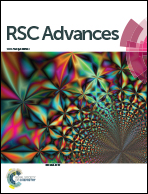Production of propionic acid via hydrodeoxygenation of lactic acid over FexOy catalysts†
Abstract
The gas-phase hydrodeoxygenation of LA to propionic acid over Fe and its oxides was firstly investigated under various conditions. The catalysts were characterized by nitrogen adsorption–desorption, XRD, FT-IR, H2-TPR and SEM. Fe3O4 as active species was confirmed. Due to that reason, Fe2O3 can be efficiently transformed in situ to Fe3O4 under an atmosphere containing hydrogen derived from decarboxylation/or decarbonylation reaction of lactic acid, which offers the most excellent catalytic performance. The catalyst is sensitive to reaction temperature. LA conversion and its consumption rate increased with an increase of reaction temperature. Similarly, propionic acid selectivity also increased with reaction temperature in the range of 360–390 °C. But with further enhancement of reaction temperature from 390 to 400 °C, it drastically decreased since the formation rate of propionic acid reduced at 400 °C. The catalyst displayed an excellent adaptability in a wide range of LA LHSV except for 1.3 h−1. More importantly, at high LA LHSV of 26.3 h−1, the catalyst offered a satisfactory stability within 100 h on stream. Under the optimal reaction conditions, 96.7% of LA conversion and 46.7% of propionic acid selectivity were achieved.


 Please wait while we load your content...
Please wait while we load your content...